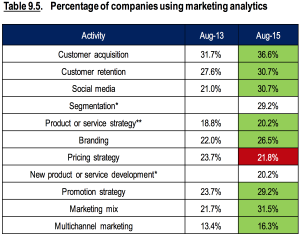
Type “growth hacks” into Google and the search results will fly off the page. Hundreds of so-called-tricks which promise to deliver 1000 percent conversion rate increases and an overnight doubling of revenue.
This isn’t one of those articles. I’m not going to promise anything. I’m not going to give you untested, untried strategies which, realistically, may have worked for one random guy in 1998 and haven’t since.
Instead, I’ll give you five online marketing hacks which we at Wishpond have used ourselves – strategies we’ve tested and proven. But even then I’ll let you know that these strategies worked for us, and are only proven for us. The #1 rule of CRO is to test, and it’s pretty much the only rule that matters.
Here are five genuine conversion rate optimization hacks that worked for us, and could for you.
1: Pre-Selected Form Fields
Many of the hacks in this article are focused on reducing barriers between traffic and conversion (or leads and conversion). This is one of the simplest.
About six months ago one of developers was talking to a friend and heard about a simple line of code which, when implemented, pre-places a visitor’s cursor (the flashing vertical line which indicates a selected field on any website) in a form field. Basically when someone came to our signup page the box for them to fill out an email address would be already selected – all they had to do was start typing.
I (genuinely) didn’t think that testing this was going to be worth the time. I mean, how much energy does it take a visitor to move their mouse an inch and select their own damn form field?

I was wrong, and my misconception is the foundation of many tests we’ve done since. Every single way you can make a visitor’s path to conversion easier should be tested and (probably) implemented.
By the time the test had reached 95 percent statistical significance, the variation beat out the control by about 45 percent. And remember this was on our signup page – it was hugely influential on our bottom-line.
Oh, and that code (by the way), is pretty simple: #$ ( “#target” ).focus();
2: Hot Leads Pre-Filled Email Fields
We want to reduce the friction between our lead and a final conversion, right? We want to grease the path in any way we can.
It starts by taking the walls down a bit. Once you’ve gotten the lead information you need (name, email address, maybe some business information) an optimized sales funnel stops asking.
Wishpond’s most eligible leads are categorized in our CRM as “Hot.” The “Hot lead” label is triggered when any non-upgraded lead who viewed our pricing page within the past 30 days takes any 10 actions within the past two days (actions like opening or replying to an email, Liking us on Facebook, viewing a product page, etc).
Leads categorized as “hot” get special attention. They’re more heavily targeted with remarketing ads, receive specific emails, and (as I said above) have a more personalized relationship with our website.
One way we do this is by implementing pre-filled form fields. When we send a nurturing email promoting email-gated content (like an ebook or webinar) when our hot lead arrives on the corresponding landing page they’re not asked to fill in their lead info again. They just hit “submit” (or whatever) and get access to the content.
Not only does this improve LP conversion rates, but also helps build our relationship and makes the nurturing process a smoother one.
3: Auto-Submit Form Fields
Auto-submit form fields are a strategy which, again, cuts down the friction in your sales funnel. Like click popups, auto-submit takes the whole “send-traffic-to-a-separate-landing-page” step out of email-gated content.
They can be used in a couple ways. Firstly, auto-submit works on an LP by auto-submitting a lead’s information once they’ve entered all the necessary information (meaning they don’t actually have to click “submit”). Secondly, auto-submit works in email by allowing your contacts or leads to register for a webinar, podcast, or conference without having to actually traffic anywhere. Embed a simple CTA and when your lead clicks on it they’re automatically registered (without having to go to any LP or website.)
When I mentioned this strategy in a previous article I got an email asking a few questions about it:

If anyone has similar questions here are my answers:

4: Javascripted, Personalized Landing Pages
Now we’re getting exciting. As you know, Javascript is a straightforward coding format (“straightforward”, of course, being a relative term when it comes to coding languages) which allows you to (among other things) personalize copy based on information you say is important.
Something Wishpond is experimenting right now is implementing Javascript on landing pages to personalize them for our traffic, thus improving conversion rates. For instance, when someone types “Facebook sweepstakes” and clicks on one of our ads for one of our product pages, the corresponding page on our website will have the headline “Facebook sweepstakes”. If they type “Facebook giveaway” or “Facebook promotion” the same page will change based on what they’ve typed into Google (or really, based on which Google adword they clicked on).
We set up several different Google ads, all with destination URLs with parameters based on search keywords. So, when someone types “facebook sweepstakes” into Google, the ad that pops up will direct them to “corp.wishpond.com/?q=sweepstakes.” Similarly, when they type “Facebook giveaway”, the ad will direct them to “www.wishpond.com/?q=giveaway.”
There’s corresponding code in the landing and product pages which changes headlines (or even body copy) based on the parameters in the URL. If the landing page sees “q=sweepstakes” the headline will read “Facebook Sweepstakes Made Simple” or something similar.
The Javascript looks like this:

Let me know if that was written in a foreign language for you and we’ll see if I can’t clear things up in the comment section!
5: Liquid Emails
If you have access to the HTML side of your email platform you can really step up the personalization side, and I’m talking substantially more than a Mailchimp merge tag.
I’m talking Liquid emails. Liquid is an open-source, ruby-based coding language which, like Javascript, allows you to affect the look of your communications based on as many parameters as you can think of.
Rather than get into the nitty-gritty (as I imagine you got enough of that in the last section), I’ll just give you a couple examples:
If you want to be sure of a solid salutation (remember, merge tags won’t capitalize your contact’s name if they’ve neglected to do so in the form field) just type…
{% if customer.firstName %}Hi {{customer.firstName | capitalize}}, {% else %}Hi there, {% endif %}
Essentially, this tells your email platform to write “Hi Jenny” if you have Jenny’s name. If you don’t have Jenny’s name it tells your platform to write “Hi there,” instead.
If you want to finish an email with “have a great weekend” if it’s sent on a Friday (we’re talking automated emails here) just type…
{% assign day = ‘now’ | date: ‘%A’ %} {% if day == ‘Friday’ %} Have a great weekend! {% else %} Have a great rest of your {{ day }}, {% endif %}
This is an awesome way to make your emails sound as personalized as possible. Normally it’d be impossible to write “have a great weekend” automatically.
Can you imagine any other ways you could use code like this in your own marketing emails?
Conclusion
Hopefully these strategies have inspired you. Again, I’m not promising they’ll double your leads overnight or boost revenue by 500 percent (though the focus-on form field can be powerful as hell). I’m just saying this stuff works for our business.
And everything’s worth testing.
Let me know if you have any questions, and we’ll hack it out in the comment section!
(191)









